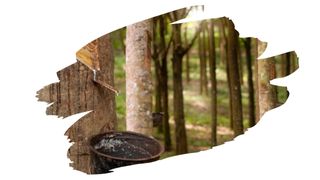Rubberwood is a surprisingly dense lumber. In fact, this solid timber is no where near as flexible as the material made from the latex liquid produced by this tree.
Instead, this South American hardwood is about as tough and hard as African Mahogany. And, just like Mahogany, Rubberwood can take on wood finishes rather well. Almost a little too well.
You see, Rubberwood has a tendency to absorb stains, paints, and oil finishes unevenly. And this in turn can end up leaving behind blotchy patchy color on the surface of Rubberwood.
So, in this post you will learn why Rubberwood needs sanding sealer (not primer) to prepare it for a coat of paint. You will also find out why paints on Rubberwood can turn out blotchy.
And keep reading to discover which easy-to-apply sanding sealer is the best choice for helping you refinish Rubberwood furniture.
This post may contain affiliate links to products that we receive a commission for (at no additional cost to you). Learn more here.
Can Rubberwood Be Refinished With A New Coat Of Paint?
It will require a little bit of prep, but it should be able to take a coat of paint.
But, if you are refinishing furniture, you need to make sure you’ve removed all of the old stain/finish/paint beforehand. Otherwise, you will experience adhesion issues when it comes down to repeating that aged wood.
Related Post: What’s With All That Sticky Residue Left Behind After Paint Stripping? [Explained!]
And What Kind Of Prep Does Rubberwood Need Before A Coat Of Paint?
Well, the wood pores of Rubberwood tend to absorb penetrating stains and oil finishes very unevenly. As a result, these liquid finishes can leave behind a blotchy coat on the surface of this timber.
And the same can be said for applying paint or primer directly onto Rubberwood. The pores of this lumber will soak up that paint/primer unevenly as well. And that will result in a patchy color on the surface of this wood.
Having said that, this tends to be more of a problem with water-based paints, such as Acrylic or Latex paint.
Related Post: Is Rubber Wood Good For Making Cutting Boards?
So How Do You Prevent Blotchy Paint Coats On Rubberwood?
You’ll need to seal Rubberwood before you apply any kind of water-based paints to it. And the way you do this is by using a clear sanding sealer.
The sealer will stop-up the open wood pores of Rubberwood. And this in turn prevents Rubberwood from fast-absorbing liquid paint/primer.
Related Post: What Is Rubberwood (And Does It Make Good Furniture?)
Why Not Use A Paint Primer? Why Use Sanding Sealer At All?
Its because the primary job of paint primers is to help a top coat of paint adhere to another surface. They act as a sort of glue, binding paint to an otherwise incompatible base coat.
Primers also can act as an undercoat, creating a white canvas for that top coat of color.
On the other hand, the primary job of sanding sealers is to fill in wood pores, cracks and gaps. And these sealers can be sanded smooth in preparation for a top coat of paint afterwards.
So, sanding sealers will do a better job at preventing uneven paint absorption (by stopping-up those wood pores).
However, undercoat primers simply aren’t as thick as sanding sealers. So they can’t pack out and fill in wood pores in the same way.
And What’s The Best Type Of Sanding Sealer For Rubber Wood?
You need to use a water-based polyurethane sanding sealer to prep Rubberwood for painting. And probably one of the best ones on the market comes from Minwax.
Minwax’s Water-Based Professional Formula Sanding Sealer won’t leave you waiting. You can start sanding and/or painting over this quick-drying sealer in as little as an hour.
But, one key caveat to remember here is that it needs to be applied directly onto natural bare wood. So, make sure you completely remove any trace of previous paint/finishes from the furniture before you apply it.
To Wrap Up, Here Are The 3 Key Takeaways From This Post…
- 1). Wood stains and water-based paints can become unevenly absorbed by Rubberwood. This can result in a blotchy coat of color.
- 2). You can prevent uneven absorption by preparing the surface of Rubberwood beforehand using sanding sealer.
- 3). Make sure you remove all trace of previous wood stains, finishes or paint before you begin refinishing Rubberwood furniture.

![A Quick Beginners Guide To Rubberwood Vs Birch Wood [For A Butcher Block Countertop] rubberwood vs birch countertop](https://www.thewoodworkplace.com/wp-content/uploads/2022/11/Banner-525-150x150.jpg)